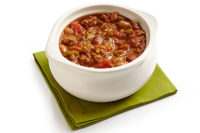2014 consumer trends Q&A with NCBA
Retailers and restaurants can benefit from the strong demand for beef.

Many external forces, from droughts and other natural disasters to rising corn prices, have greatly impacted the price of beef in recent years. According to the latest data from the USDA’s Economic research service, the price of ground beef has risen from $2.99/pound in August 2012 to $3.45 in August 2013. The prices for other beef products and cuts have risen by anywhere from 10 cents to 70 cents per pound as well.
However, the consumer demand for beef is still high, according to the national Cattleman’s Beef Association. Trevor Amen, director of market intelligence, reports that 2012 saw an increase in beef purchases in both volume and dollars at the foodservice level. Likewise, there has been positive growth in dollar sales at retail, even if volume has decreased. He adds that there are many ways to increase purchases for beef at both the restaurant and retail level.
Amen says that consumers are still very price-conscious and shop using the advertisements from grocery stores. Competitive pricing and featuring beef in those ads may help attract consumers, but retailers also need to take an educational role with their shoppers as well.
“Helping them understand how to select the right cut and prepare beef is really the greatest opportunity to help them feel more comfortable with making that purchase and adding to the variety of meals that they are comfortable preparing for their family,” Amen says.
Amen notes that the new and emerging cuts introduced by the NCBA have been in the marketplace for several years, but there are still many opportunities to understand those muscles and cuts and market them to the consumer in the most positive way.
“As a result of muscle profiling funded by the Checkoff for over 10 years now, we have a wide variety of tests and can understand their eating attributes, like flavor profile and tenderness,” he says.
The flat-iron steak is the most popular of the “new” cuts and has become the sixth most popular steak at restaurants and the 14th most popular at grocery stores. Amen says that 83 million pounds of flat irons were sold to the foodservice industry in 2012, an increase of 9.5 percent from the previous year. The petite tender has likewise become a mainstream steak, with 30 million pounds sold in 2012. While those two cuts in particular have gained a following, there are many opportunities to market a more cost-effective steak entrée.
Amen also notes the proliferation of beef as an ingredient at restaurants. Innovative chefs are finding ways to include beef in the menu with a lower price point than a typical steak.
“For example, beef-based Asian bowls have seen an increase of 13 percent year over year,” Amen notes. “Beef-based pasta dishes had 6 percent growth, entrée salads 5 percent growth, and beef or steak pizza had 9 percent growth.
“You can see operators understand their customers love beef, and they’re finding ways to cost-effectively include it on their menu,” he adds.
Amen also recommends that restaurants experiment with innovative presentation techniques, offering up smaller versions of traditional favorites that may appeal to a larger group of customers.
Many types of restaurants can take advantage of beef’s versatility by including it in more entrée items or in more dayparts. Amen also points to the smoked beef brisket that was a popular limited-time item at Arby’s as a way to not only use beef in a different format but also take advantage of the resurgent demand for smoked meats. That sandwich was developed in partnership with the Beef Checkoff.
“The smoked beef brisket is one that we think is a great menu item that was developed after extensive research and learning that consumers showed a strong interest in smoked meats,” he says.
Looking for a reprint of this article?
From high-res PDFs to custom plaques, order your copy today!








